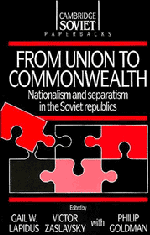Book contents
- Frontmatter
- Contents
- Notes on the contributors
- Preface
- Glossary
- Map: the Soviet Successor States
- 1 Introduction: Soviet federalism – its origins, evolution, and demise
- 2 State, civil society, and ethnic cultural consolidation in the USSR – roots of the national question
- 3 From democratization to disintegration: the impact of perestroika on the national question
- 4 The evolution of separatism in Soviet society under Gorbachev
- 5 Perestroika and the ethnic consciousness of Russians
- 6 Nationality policies in the period of perestroika: some comments from a political actor
- Index
6 - Nationality policies in the period of perestroika: some comments from a political actor
Published online by Cambridge University Press: 03 May 2011
- Frontmatter
- Contents
- Notes on the contributors
- Preface
- Glossary
- Map: the Soviet Successor States
- 1 Introduction: Soviet federalism – its origins, evolution, and demise
- 2 State, civil society, and ethnic cultural consolidation in the USSR – roots of the national question
- 3 From democratization to disintegration: the impact of perestroika on the national question
- 4 The evolution of separatism in Soviet society under Gorbachev
- 5 Perestroika and the ethnic consciousness of Russians
- 6 Nationality policies in the period of perestroika: some comments from a political actor
- Index
Summary
The years of perestroika, especially the last two or three years, were marked by an unprecedented upsurge of national movements, national agitations, and conflict. These national movements arose for different reasons throughout the Soviet Union. In some areas, like the Baltic states, national movements have been distinguished by the striving for the establishment of state independence, and they developed in the framework of a constitutional process – even, to some extent, after the abortive coup in August 1991. In other regions, particularly in Central Asia and the Caucasus, or on the border line dividing the Islamic and Christian worlds, nationality conflicts generally took a violent form, as demonstrated by the clashes between Armenia and Azerbaijan. They began with the unrest of December 1986 in Alma-Ata, which was followed by outbreaks in Nagorno-Karabakh in 1988. These events were completely unexpected by the public, by experts on nationalities, by the press, and by political authorities. Why was this the case?
Soviet social science, always obedient to authority, began to develop the concept of the Soviet people as a new historical community in the late 1960s. This was only a smoke-screen to hide the attempts at the forced and accelerated assimilation of non-Russian nationalities. This assimilation was not initiated by the Russian people, who were themselves subject to a considerable de-ethnocization.
- Type
- Chapter
- Information
- From Union to CommonwealthNationalism and Separatism in the Soviet Republics, pp. 114 - 121Publisher: Cambridge University PressPrint publication year: 1992
- 1
- Cited by



